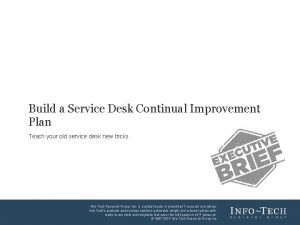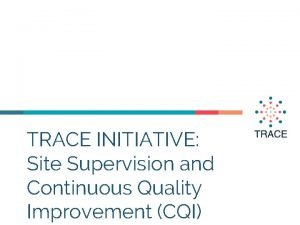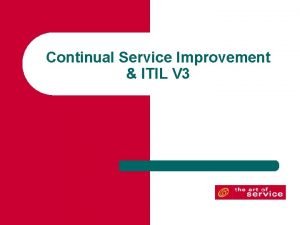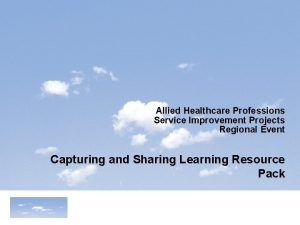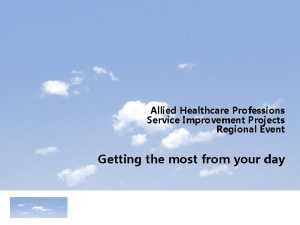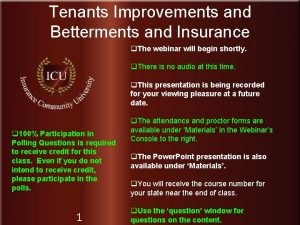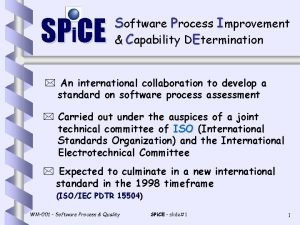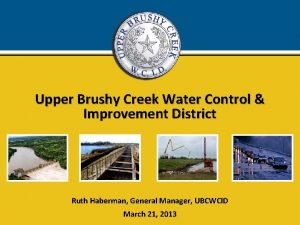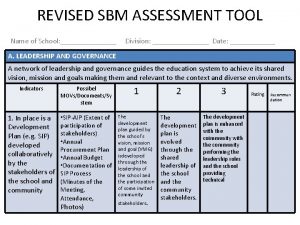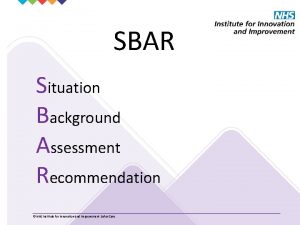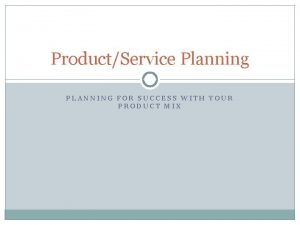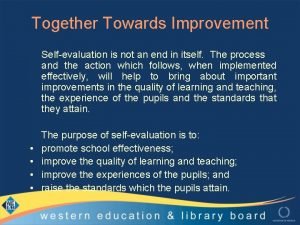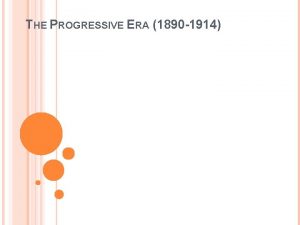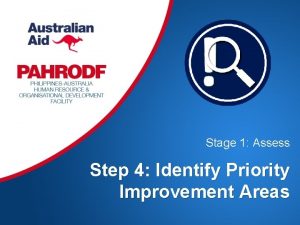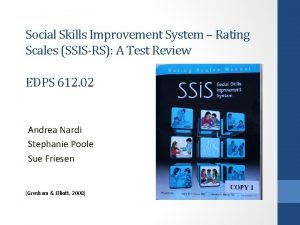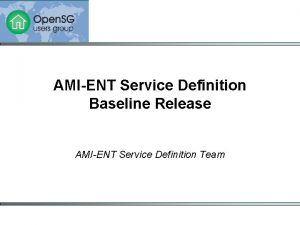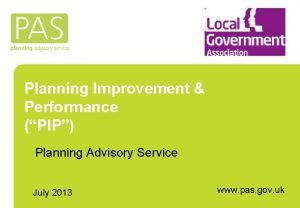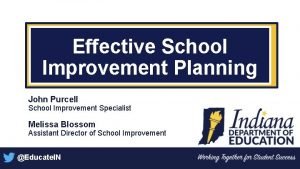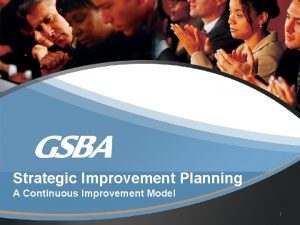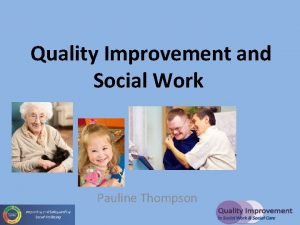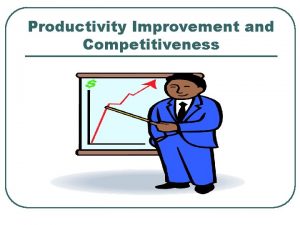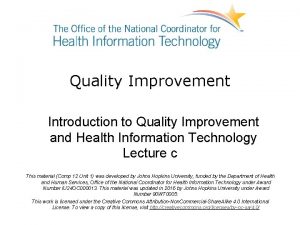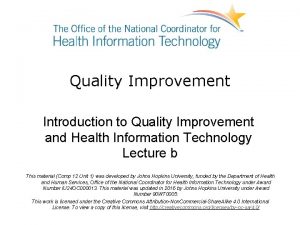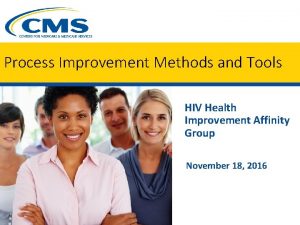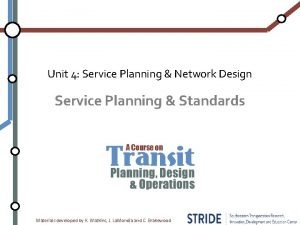Definition of service planning and improvement Service planning


























- Slides: 26

Definition of service planning and improvement ² Service planning is when you develop and describe a vision of what you want health and social services to be like - you create goals and action steps to achieve that vision ² Service improvement is when you develop health and social services to improve the quality of services and how much service provision is available. ² Both service planning and improvement include: ¶ the overall planning you do ¶ how you put your plan into action ¶ how you check on (review) your progress ¶ how you evaluate the outcomes achieved Birmingham Heartlands & Solihull NHS Trust (Teaching) 1 A

Purpose of service planning and improvement ² Service planning: To create services that match what is needed for a particular group or people or a particular area and to see what resources you need to do this ² Service improvement: To improve services to address problems that exist, or to find even better ways of doing things ² For both you do this in an organised way so you: ¶know what you want to achieve and how you will get there ¶ can monitor progress to make sure you stay on track ¶ can involve users, carers and the public in the work Birmingham Heartlands & Solihull NHS Trust (Teaching) 1 B

When does user involvement in service planning happen? ² When users, carers and the public influence how an organisation: ¶makes new plans for an existing service to improve or expand it, and ¶decides how to monitor and evaluate it, OR ¶plans a new service or project, and ¶works out how to monitor and evaluate it Birmingham Heartlands & Solihull NHS Trust (Teaching) 1 C

A model for service planning and improvement REVIEW Did we get there? ASSESS Where are we at now? GOALS Where do we want to go? Planning, action and review cycle ACTION Take action go there! Birmingham Heartlands & Solihull NHS Trust (Teaching) ACTION STEPS What do we do to get there? INDICATORS How will we know we got there? Based on Consumer Focus Collaboration (2000, p. 6) 1 D

Steps 1 and 2 ² Assess the current situation that is the ASSESS Where are we at now? focus of the planning: ¶What are the main issues? ¶What is needed and why? ¶What resources ($, people, buildings, etc) do you have to work with? GOALS Where do we want to go? ² Identify what goals you have for the situation: ¶What do you want to achieve? ¶Why is this important? Birmingham Heartlands & Solihull NHS Trust (Teaching) 1 E

Steps 3 and 4 ² Decide what indicators will let you know INDICATORS How will we know we got there? that you have been successful at reaching your goal: ¶What would you see, hear or experience? ¶What would others see, hear or experience? ACTION STEPS What do we do to get there? ² Develop steps you must put into action so you can reach the goals: ¶What are the smaller actions to take that combined together get you to the goal? Birmingham Heartlands & Solihull NHS Trust (Teaching) 1 F

Steps 5 and 6 ² Start putting these steps into action: ACTION Take action go there! ¶These steps will involve many people in a health and social service, including users, carers and the public ² Review your progress along the way to check you are on the right track: REVIEW Did we get there? ¶Do this regularly so you can pick up problems quickly and deal with them ¶Ask people’s opinions on how it is going ¶Often a formal review happens where Birmingham Heartlands & Solihull NHS Trust (Teaching) the service or someone else evaluates if the plan was carried out well 1 G

When does user involvement in service improvement happen? ²When users, carers and the public: ¶give feedback on what existing services are like ¶help work out how to get this feedback from a wider range of people ¶help gather the feedback ¶look at the feedback and help decide what the organisation should improve ¶participate in making decisions about what the organisation will do to improve Birmingham Heartlands & Solihull NHS Trust (Teaching) 1 H

Questions to guide service improvement ² What opinions do people have about existing services? ² What is working well? ¶Why does it work well? ² What is not working well? ¶Why does it not work well? ² What should happen to keep, improve and increase what is working well? Birmingham Heartlands & Solihull NHS Trust (Teaching) 1 I

Questions to guide service improvement ² What should happen to stop, prevent and decrease what is not working well? ² Does the service reach all of the people who need to use it? ¶Why or why not? ² What else needs to happen so that people receive good quality and relevant services? ¶Are new or different services needed? Birmingham Heartlands & Solihull NHS Trust (Teaching) 1 J

Opportunities for user involvement – Clinical guidelines ² Clinical guidelines: ¶are recommendations for the care of service users by health and social service professionals ¶identify good practice - but are also general as they do not take into account every individual situation ¶assist staff and service users to make decisions about appropriate care for specific health or social issues, e. g. coronary heart disease, cancer, diabetes, mental illness ¶are used to help achieve clinical effectiveness – this means how well an intervention or treatment creates an overall health benefit in everyday clinical practice in health and social services Birmingham Heartlands & Solihull NHS Trust (Teaching) 2 A

Example 1 – Clinical guidelines ² The Royal College of Nursing worked with Action for Sick Children (ASC) on guidelines for pain management in children - the following things happened: ¶The ASC nominated a parent to be on the guideline development group ¶The developers used different methods to directly gain perspectives from children of different ages – play scenarios, interviews and a children’s workshop ¶Children said that staff often do not believe their pain, so: w The final guideline had a whole section on both managing and assessing pain in children w The developers had not originally thought of including this Birmingham Heartlands & Solihull NHS Trust (Teaching) 2 B

Opportunities for user involvement – Audit ² Audit – also called clinical audit: ¶comparing how well a service is performing against an agreed and specific benchmark of what the service should be doing in that situation, e. g. care of a particular health or social problem, user involvement ² Audit work is commonly used to determine the need for service improvement ² It can be repeated at a later time to check how well a service has gone with making changes Birmingham Heartlands & Solihull NHS Trust (Teaching) 2 C

Example 2 – Audit ² The Commission for Healthcare Audit and Improvement set up review teams of 6 -8 members to audit NHS Trusts: ¶ a NHS doctor ¶ Nurse ¶ professional related to health, e. g. a pharmacist or occupational therapist ¶ a lay member ¶ an NHS manager ¶ a CHAI review manager ¶ additional service user and carers may be included ² They are trained for the role, spend time preparing for the audit, visit the Trust for a full week, and then help with writing up the report Birmingham Heartlands & Solihull NHS Trust (Teaching) 2 D

Opportunities for user involvement – Service and workforce planning or improvement ² Service and workforce planning or improvement – where services follow a planning cycle like the one in Activity 1: ¶ assess the needs of the people who are affected by the service ¶ discuss what could happen to meet these needs and work out if they are realistic, or if you need to get new resources so you can do them - for example, you need to ask things like: w Do you have enough staff? w Are they qualified to offer the new or improved service? ¶ set goals, create action steps to achieve them and work out what indicators will let you know they have been achieved ¶ carry out the actions, monitor progress and review it at agreed points in time, e. g. every 6 months Birmingham Heartlands & Solihull NHS Trust (Teaching) 2 E

Example 3 – Service and workforce planning and improvement ² ‘Involving Older People in Worcestershire Social Services’ ¶ eight Older People’s Forums have been set up ¶ members are older people living in the local area and representatives of local services ¶ they sit on many Primary Care Trust groups and are involved in all 6 District Councils for their area ¶ they discuss and identify issues for improvement in services for older people, then make action plans to ensure these changes take place. For example: w they meet with senior Social Services Managers 4 times/yr and have convinced them to include bathing and housework within the service w they are campaigning for a coordinated County-wide Concessionary Travel scheme for older people Birmingham Heartlands & Solihull NHS Trust (Teaching) 2 F

Opportunities for user involvement – ‘Walkabouts’ ²Doing ward or service ‘walkabouts’: ¶this is when the representatives from Patient Forums go by themselves to observe what is happening and use this information to provide feedback to the service ¶they can also do ‘chairman walkabouts’ when the chairman goes around wards or departments to learn about what is happening, talk with staff and gain feedback from service users Birmingham Heartlands & Solihull NHS Trust (Teaching) 2 G

Example 4 – Walkabouts ² The Patient and Carer Advisory Panel at the Birmingham Heartlands and Solihull NHS Trust: ¶has 20 members and meets bimonthly to discuss many issues relating to both trusts ¶members from the Black and Ethnic Advisory Group and the Disability Forum also attend meetings to collaborate on dealing with patient and carer issues ¶do walkabouts/visits to ward areas to look at areas such as: w w w infection control and cleaning standards signposting staff attitude storage health and safety Birmingham Heartlands & Solihull NHS Trust (Teaching) 2 H

Opportunities for user involvement – Training and staff recruitment ² Support training programmes for health and social service staff – this can include things like: ¶being part of the induction or orientation programme for new staff in the service ¶teaching staff about user involvement ¶contributing to management training ² Participate in staff recruitment – being on a panel that: ¶reads all the job applications ¶creates a short list of people to be interviewed ¶does the interviews and makes the final decision Birmingham Heartlands & Solihull NHS Trust (Teaching) 2 I

Opportunities for user involvement – Communication ² An important starting point for relationships between services and users, carers and the public is how information is communicated - you could get involved in: ¶reviewing and creating service user/carer information, e. g. w in-house magazines w in-house radio w health brochures ¶being on reading panels to ensure patient information leaflets are easy to read ¶developing and expanding the service website to make sure it is user-friendly and also identifies the user involvement work happening in the organisation Birmingham Heartlands & Solihull NHS Trust (Teaching) 2 J

Outcomes from user involvement in service planning and improvement ² When health and social service staff work in partnership with users and carers, then users and carers: ¶are more satisfied and less anxious ¶are more likely to make positive health and personal changes to improve their situation ¶stick with these changes more easily ¶are more likely to take medication if that is needed ¶have fewer service visits ¶have better physical and mental health – they recover more quickly or can prevent things getting worse Birmingham Heartlands & Solihull NHS Trust (Teaching) 3 A

Outcomes from user involvement in service planning and improvement ² A recent review found: “Patients have contributed to the planning and development of services across a range of settings, but the effects of this process on the quality and effectiveness of services are unknown. This absence of evidence should not be mistaken for an absence of effect. ” Birmingham Heartlands & Solihull NHS Trust (Teaching) 3 B

Outcomes from user involvement in service planning and improvement ²Evidence means a careful evaluation of: ¶what happened ¶who was involved ¶what they achieved together for the organisation ¶how the process affected: w them w other health and social service staff w other users, carers or members of the public Birmingham Heartlands & Solihull NHS Trust (Teaching) 3 C

Outcomes from user involvement in service planning and improvement ² “User consultants can be involved as employees, trainers or researchers without detrimental effect” to themselves or health and social service staff ² User consultants who train health and social service staff have a positive influence on trainee attitudes ² When user consultants do not have decision-making roles in partnership with staff then their influence depends on how much managers listen to them ¶ if staff decide not to listen this undercuts user involvement Birmingham Heartlands & Solihull NHS Trust (Teaching) 3 D

Outcomes from user involvement in service planning and improvement ² When the service has weak foundations and poor support for user involvement it is more difficult for user consultants’ voices to be heard. So… “If we are to witness any real engagement with users in decision-making …there is a prerequisite for a more equal partnership between professionals and patients to evolve which will enable the involvement of lay people to occur at all levels” Birmingham Heartlands & Solihull NHS Trust (Teaching) 3 E

Outcomes from user involvement in service planning and service improvement ² When health and social services do listen to users, carers and the public they may be surprised to hear that all is not bad: ¶there is often a lot of positive feedback about services ¶this can boost staff morale ¶it may start to win over the hearts and minds of staff to support user involvement ² If you are an optimist, then you will believe that from little things big things grow Birmingham Heartlands & Solihull NHS Trust (Teaching) 3 F
 Itil csi 7 steps
Itil csi 7 steps Service desk improvement initiatives
Service desk improvement initiatives Cqi action plan template
Cqi action plan template Itil service metrics
Itil service metrics The allied health profession service improvement project
The allied health profession service improvement project The allied health profession service improvement project
The allied health profession service improvement project It consolidation strategy
It consolidation strategy Trial and improvement examples
Trial and improvement examples If you can't measure it it doesn't exist meaning
If you can't measure it it doesn't exist meaning Improvements & betterments
Improvements & betterments Software process improvement and capability determination
Software process improvement and capability determination Brushy creek water
Brushy creek water Latest sbm assessment tool
Latest sbm assessment tool Nhs institute for innovation and improvement sbar
Nhs institute for innovation and improvement sbar Inactivism planning
Inactivism planning Short medium and long term planning in education
Short medium and long term planning in education Language planning ppt
Language planning ppt Product/service planning
Product/service planning Work improvement teams singapore
Work improvement teams singapore Four improvement strategies in tqm
Four improvement strategies in tqm Together towards improvement
Together towards improvement When was the progressive era? *
When was the progressive era? * Fha title 1 loan
Fha title 1 loan Performance improvement plan examples
Performance improvement plan examples Winning colors jrotc
Winning colors jrotc Data collection plan examples
Data collection plan examples Ssis-rs
Ssis-rs

